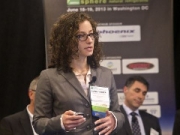The refrigeration condenser: how the different types affe...
About this presentation
related to ATMOsphere America 2013
published on 19 June 2013
14 pages
2 MB
This presentation compares air-cooled, evaporative and hybrid condensers in terms of first costs and operating costs, looking at peak demand in kW, total energy use in kWh, and water use. Additional condenser options are presented as well as carbon footprint savings from reduced refrigerant charge and electricity savings.
About the speaker(s)
Preston P. Blay

Beginning his career as an engineer in the semiconductor industry, Preston has spent the last 10 years in refrigeration and HVAC. At Baltimore Aircoil Company, he has held the roles of Sales Manager, Latin America Market Manager and currently is the Director of BAC's Refrigeration products for the Americas. Preston has has been hailed as one of the Nation’s top engineers by Inventors Digest and recognized for innovative ways of bridging the gap between technology and business by Minority Engineer magazine.
Preston holds a B.S. in Mechanical Engineering from The Rochester Institute of Technology and an M.B.A. from St. Edwards University. He is also a licensed Professional Engineer, a Certified Energy Manager, and a LEED AP. He is a member of ASHRAE, AHRI, IIAR, RETA, and AEE. While having held a Board of Directors position with RETA, he is currently a sub-section chair on the AHRI-IRHT committee.
Ilana Cember

As the lead engineer for Baltimore Aircoil's TrilliumSeries™ hybrid condenser line, Ilana develops the modeling tools necessary to analyze energy consumption and system performance. Passionate about sustainability, she acts as the liaison between BAC and legislative groups promoting energy efficiency, natural refrigerants, and green building.
Ilana has a BS in Mechanical Engineering from Johns Hopkins University, with a focus on energy engineering. She is a Professional Engineering in Training, Certified Energy Manager, and LEED Green Associate.

